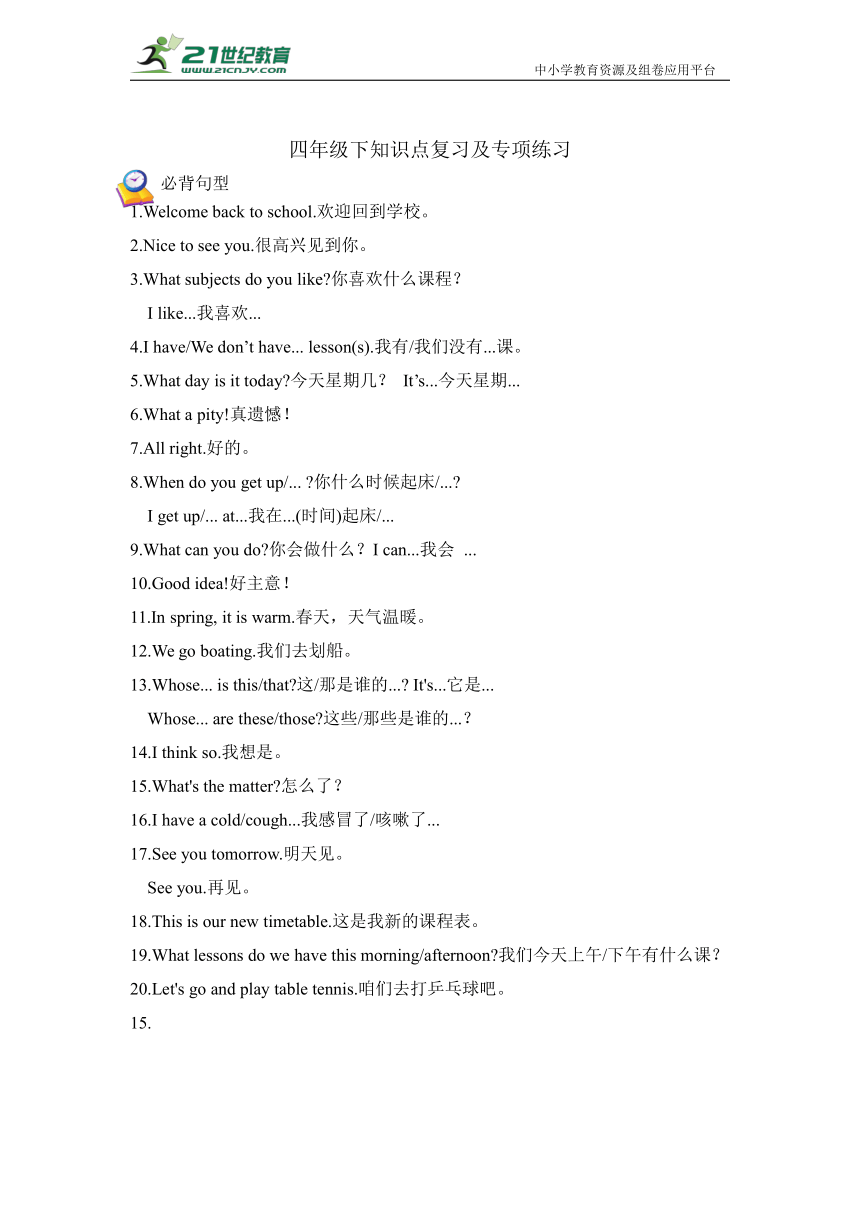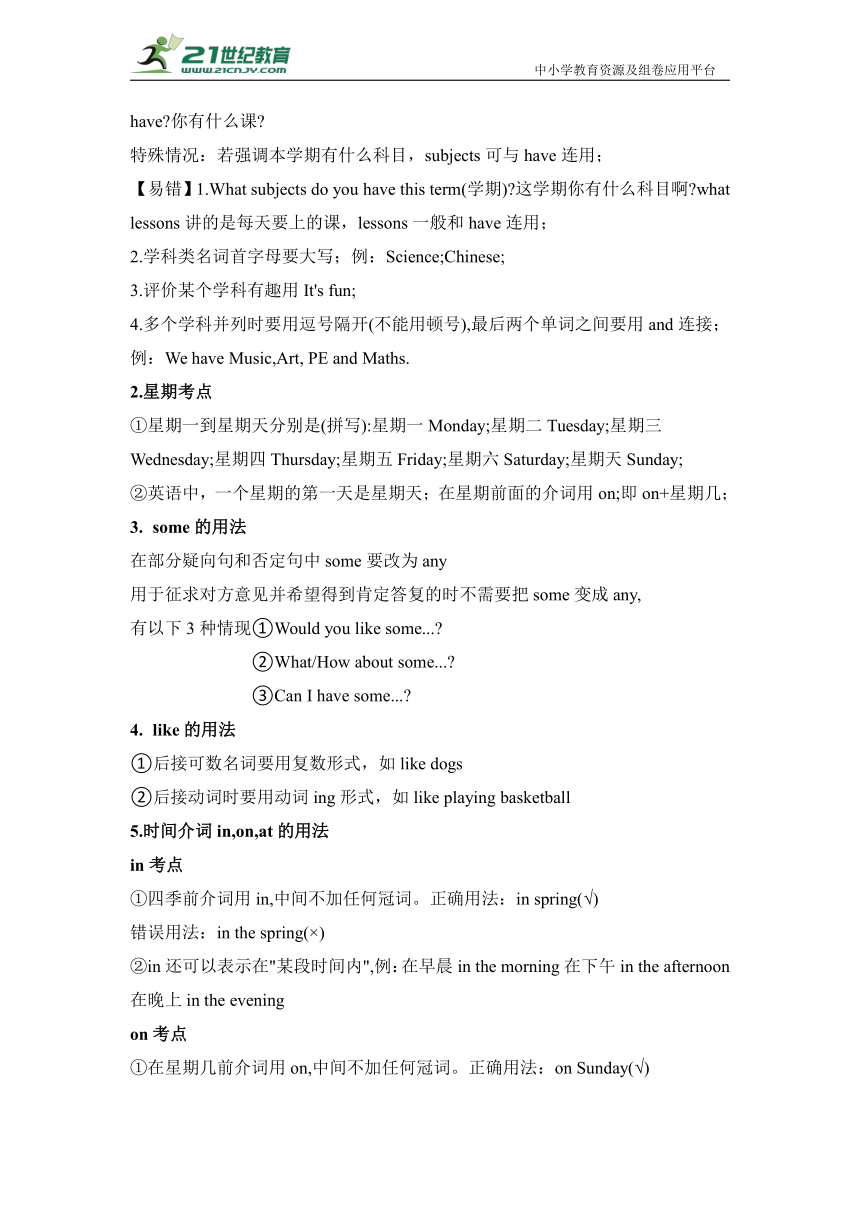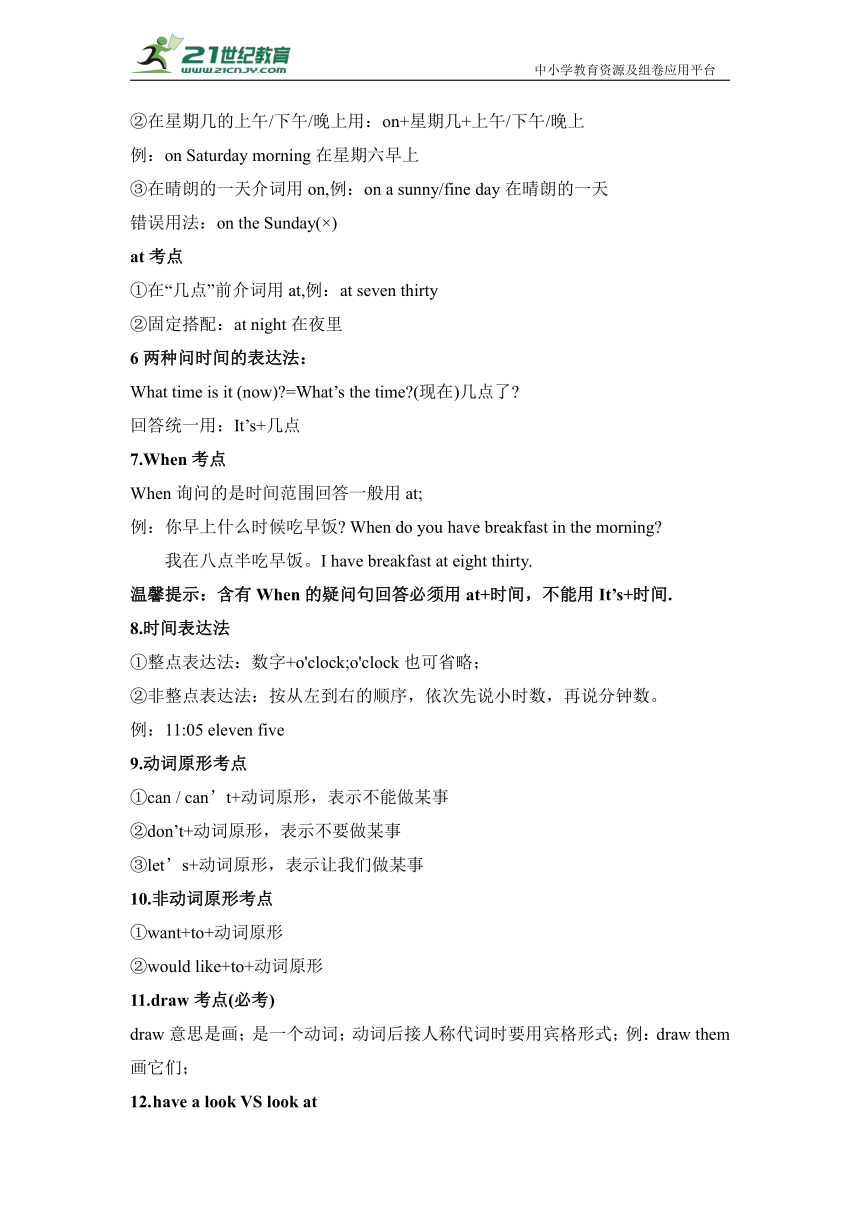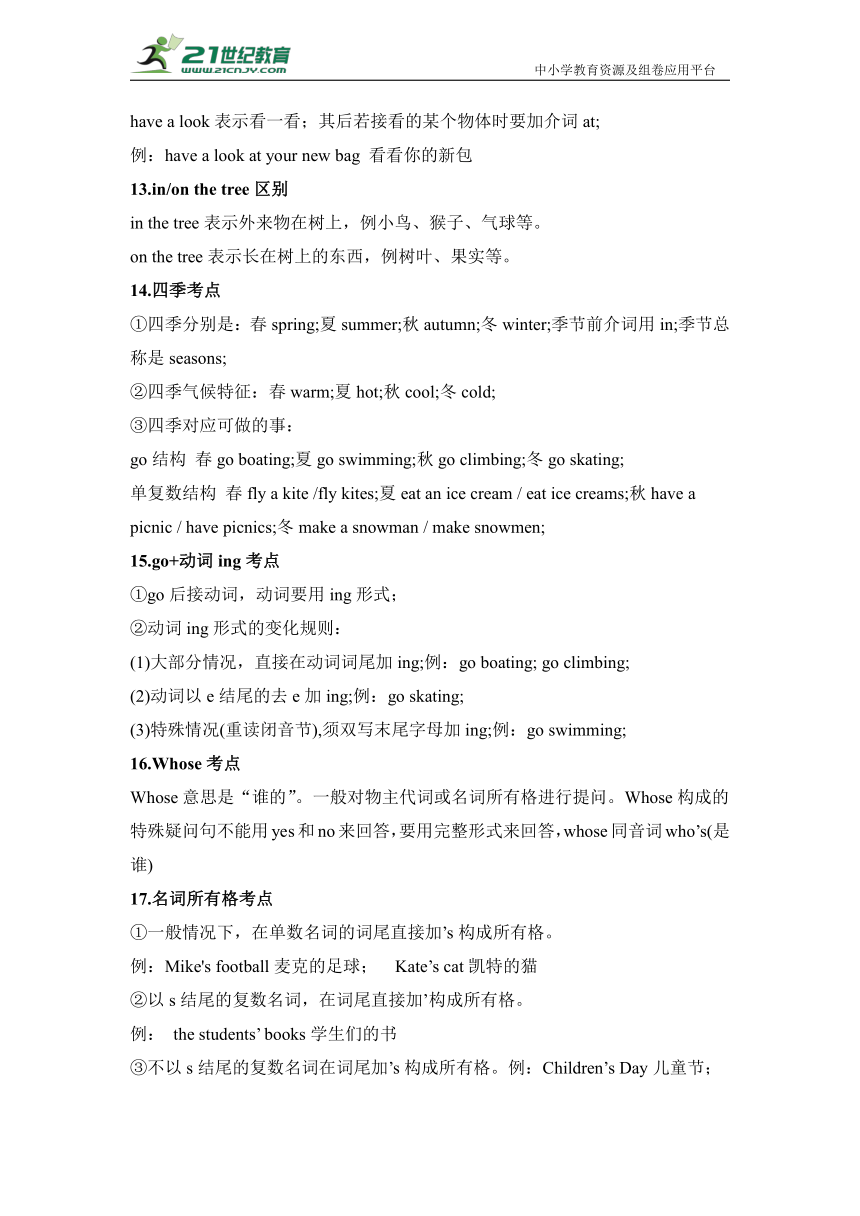【牛津译林版 英语期末复习一本通 】第四讲 四年级下知识复习及专项训练
文档属性
| 名称 | 【牛津译林版 英语期末复习一本通 】第四讲 四年级下知识复习及专项训练 |  | |
| 格式 | docx | ||
| 文件大小 | 323.8KB | ||
| 资源类型 | 试卷 | ||
| 版本资源 | 牛津译林版 | ||
| 科目 | 英语 | ||
| 更新时间 | 2023-06-20 16:55:49 | ||
图片预览





文档简介
中小学教育资源及组卷应用平台
四年级下知识点复习及专项练习
必背句型
1.Welcome back to school.欢迎回到学校。
2.Nice to see you.很高兴见到你。
3.What subjects do you like 你喜欢什么课程?
I like...我喜欢...
4.I have/We don’t have... lesson(s).我有/我们没有...课。
5.What day is it today 今天星期几? It’s...今天星期...
6.What a pity!真遗憾!
7.All right.好的。
8.When do you get up/... 你什么时候起床/...
I get up/... at...我在...(时间)起床/...
9.What can you do 你会做什么?I can...我会 ...
10.Good idea!好主意!
11.In spring, it is warm.春天,天气温暖。
12.We go boating.我们去划船。
13.Whose... is this/that 这/那是谁的... It's...它是...
Whose... are these/those 这些/那些是谁的...?
14.I think so.我想是。
15.What's the matter 怎么了?
16.I have a cold/cough...我感冒了/咳嗽了...
17.See you tomorrow.明天见。
See you.再见。
18.This is our new timetable.这是我新的课程表。
19.What lessons do we have this morning/afternoon 我们今天上午/下午有什么课?
20.Let's go and play table tennis.咱们去打乒乓球吧。
15.
Can you see... on the river 你能看见河面上 有……吗?
16.What's in this big box 这只大箱子里有什么?
17.What can you see in it 你能看见里面有什 么吗?
18.It's a fine day today!今天天气很好!
19.Here's your jacket.这里是你的夹克衫。
20.Is this your... 这是你的 吗?
Yes, it is. /No, it isn’t.是的,它是。/不,它 不是。
21.It’s too short/long.它太短/长了。
Your trousers are too...你的裤子太...了。
22.Let's go to the party.咱们去参加聚会吧。
23.It's so beautiful.它是如此漂亮。
24.What’s this 这是什么?
e and have a pie.来吃一个馅饼。
26.I’m not hungry.我不饿。
27.Can I have some water 我能喝一些水吗?
28.Are you ill 你病了吗?
29.I want to go to bed.我想睡觉。
30.Here’s some water.这里有一些水。
31.I can’t come to school today.我今天不能来学校。
32.I’m sorry to hear that,听到那个消息我很难过。
33.Take care.保重。
34.We don’t have any lessons on Sunday. 我们星期天没有课。
35.Can I come to see you after school 放学后我能来看你吗?
语法知识点归纳
1.what subjects和what lessons的区别及考点
what后面的学科和课要加s;即what subjects和what lessons;what subjects意思是学科,subjects一般和like连用;例:What subjects do you like 你喜欢什么学科 what lessons意思是课程,lessons一般和have连用;例:What lessons do you have 你有什么课
特殊情况:若强调本学期有什么科目,subjects可与have连用;
【易错】1.What subjects do you have this term(学期) 这学期你有什么科目啊 what lessons讲的是每天要上的课,lessons一般和have连用;
2.学科类名词首字母要大写;例:Science;Chinese;
3.评价某个学科有趣用It's fun;
4.多个学科并列时要用逗号隔开(不能用顿号),最后两个单词之间要用and连接;例:We have Music,Art, PE and Maths.
2.星期考点
①星期一到星期天分别是(拼写):星期一Monday;星期二Tuesday;星期三Wednesday;星期四Thursday;星期五Friday;星期六Saturday;星期天Sunday;
②英语中,一个星期的第一天是星期天;在星期前面的介词用on;即on+星期几;
some的用法
在部分疑向句和否定句中some要改为any
用于征求对方意见并希望得到肯定答复的时不需要把some变成any,
有以下3种情现①Would you like some...
②What/How about some...
③Can I have some...
like的用法
①后接可数名词要用复数形式,如like dogs
②后接动词时要用动词ing形式,如like playing basketball
5.时间介词in,on,at的用法
in考点
①四季前介词用in,中间不加任何冠词。正确用法:in spring(√)
错误用法:in the spring(×)
②in还可以表示在"某段时间内",例:在早晨in the morning在下午in the afternoon在晚上in the evening
on考点
①在星期几前介词用on,中间不加任何冠词。正确用法:on Sunday(√)
②在星期几的上午/下午/晚上用:on+星期几+上午/下午/晚上
例:on Saturday morning在星期六早上
③在晴朗的一天介词用on,例:on a sunny/fine day在晴朗的一天
错误用法:on the Sunday(×)
at考点
①在“几点”前介词用at,例:at seven thirty
②固定搭配:at night在夜里
6两种问时间的表达法:
What time is it (now) =What’s the time (现在)几点了
回答统一用:It’s+几点
7.When考点
When询问的是时间范围回答一般用at;
例:你早上什么时候吃早饭 When do you have breakfast in the morning
我在八点半吃早饭。I have breakfast at eight thirty.
温馨提示:含有When的疑问句回答必须用at+时间,不能用It’s+时间.
8.时间表达法
①整点表达法:数字+o'clock;o'clock也可省略;
②非整点表达法:按从左到右的顺序,依次先说小时数,再说分钟数。
例:11:05 eleven five
9.动词原形考点
①can / can’t+动词原形,表示不能做某事
②don’t+动词原形,表示不要做某事
③let’s+动词原形,表示让我们做某事
10.非动词原形考点
①want+to+动词原形
②would like+to+动词原形
11.draw考点(必考)
draw意思是画;是一个动词;动词后接人称代词时要用宾格形式;例:draw them画它们;
have a look VS look at
have a look表示看一看;其后若接看的某个物体时要加介词at;
例:have a look at your new bag 看看你的新包
13.in/on the tree区别
in the tree表示外来物在树上,例小鸟、猴子、气球等。
on the tree表示长在树上的东西,例树叶、果实等。
14.四季考点
①四季分别是:春spring;夏summer;秋autumn;冬winter;季节前介词用in;季节总称是seasons;
②四季气候特征:春warm;夏hot;秋cool;冬cold;
③四季对应可做的事:
go结构 春go boating;夏go swimming;秋go climbing;冬go skating;
单复数结构 春fly a kite /fly kites;夏eat an ice cream / eat ice creams;秋have a picnic / have picnics;冬make a snowman / make snowmen;
15.go+动词ing考点
①go后接动词,动词要用ing形式;
②动词ing形式的变化规则:
(1)大部分情况,直接在动词词尾加ing;例:go boating; go climbing;
(2)动词以e结尾的去e加ing;例:go skating;
(3)特殊情况(重读闭音节),须双写末尾字母加ing;例:go swimming;
16.Whose考点
Whose意思是“谁的”。一般对物主代词或名词所有格进行提问。Whose构成的特殊疑问句不能用yes和no来回答,要用完整形式来回答,whose同音词who’s(是谁)
17.名词所有格考点
①一般情况下,在单数名词的词尾直接加’s构成所有格。
例:Mike's football麦克的足球; Kate’s cat凯特的猫
②以s结尾的复数名词,在词尾直接加’构成所有格。
例: the students’ books学生们的书
③不以s结尾的复数名词在词尾加’s构成所有格。例:Children’s Day儿童节; men’s shoes男鞋; women’s clothes女士服装
18.a pair of考点
a par of后接复数名词,pair同音词pear
一类是由两个相连接部分组成,例trousers,jeans, shorts.一类是成双成对使用的物品,例shoes,socks, gloves,a pair of jeans一条牛仔裤two pairs of shorts两条短裤this pair of trousers这条裤子a pair of trousers指一条裤子,不能直接说a trousers或者two trousers。
19.What's the matter with 考点
想知道对方出了什么状况我们可以用此提问,表示关心。
①What's the matter with+人称代词宾格例:What’s the matter with you(你,你们)/him(他)/her(她)/them(他们)怎么了
②What’s the matter with+具体人名 表示某人怎么了
例:What's the matter with Tom 汤姆怎么了
③What’s the matter 没有with...的情况默认翻译为(你)怎么了
注:U7主要对I'm cold/hot/hungry/thirsty/tired等形容词进行提问。
温馨提示:What’s the matter with sb.(某人) =What’s wrong with sb.(某人)
want 与want to do考点
want.;表示想要.want后接名词;
want to do sth.表示想要做某事;want后接动词时;需在want后加to;
温馨提示:want = would like; would like考点与want相同;
21.电话用语
①电话用语中“我”用this,“你”用that表示;不能用I和you;
我是用This is… 你是…吗 用Is that ..
②speak的ing考点
我是…用This is…speaking.表示正在接听电话的是..其中的speaking也可省略;③speak原形考点
May I speak to Miss Li 我可以和李老师通话吗 May为情态动词;表示可以;故speak要用原形;speak to ….表示与…说话;to不能省略;
22.I'm sorry to hear that考点
I’m sorry to hear that当听到不好或者不幸的消息时,英美人常用这句话表示同情和关怀。翻译为:“听到那个消息我很难过”;hear同音词here。
23.How are you 考点
How are you 是询问对方身体情况的句式;
回答情况分为三种:
(1)身体情况很好:I’m fine.Thank you.
(2)身体情况一般:Not bad, thank you.
(3)身体情况不好:Not so good.
24.疾病考点
结构:have a+疾病
感冒have a cold咳嗽have a cough头疼have a headache发烧have a fever
除fever外;例果表示病情严重可在疾病前加bad;例:have a bad cold;得了重感冒;表示“发高烧”只能用have a high fever;不可用bad;对疾病提问用“What's the matter ”
重难点句型解析
原文再现:What subjects do you like, Wang Bing 王兵,你喜欢什么课程?
解析:在谈论喜欢的课程时,通常是指这门课程而不是某一节课(lesson).所以通常会说What subjects do you like ,而不是What lessons do you like 。
subject和lesson的用法区别:
当要表达自己喜欢的课程时只能用subject。 如:
—What subjects do you like 你喜欢什么课程?
—I like Science and Art.我喜欢科学和美术。
当要表达有什么课或者课程时,subject和 lesson都适用,但表达的意思略有区别。如:
—What lessons do you have today 你今天有 什么课?
—I have Chinese, Maths, English and PE. 我有语文、数学、英语和体育课。
—What subjects do you have this term 你这 学期有哪些课程?
—I have Chinese, Maths, English, Science, Music, Art and PE.我有语文、数学、英语、科学、 音乐、美术和体育课。
原文再现:We don't have any lessons on Saturday. 星期六我们没有课。
解析:any除了用于疑问句之外,还常用于否定句。
如:
Do you have any toys 你有一些玩具吗?
原文再现:When do you go to school 你什么时候上学?
I usually go to school at seven forty.我通常七点四十上学。
解析:when是“什么时候,什么时间”的意思,常用来引导特殊疑问句。当询问具体的时间时,也可以用what time 提问。如:
—What time do you go to bed every day 你 每天几点睡觉?
—At nine.九点。
原文再现:What can you see over there 在那里你能看见什么?
解析:see表示“看见,看到”,强调看的结果。如:
Can you see a cake over there 你能看见那里的蛋糕吗?
look通常用来引起对方的注意,强调看的动作。如:
Look! That's my father.看!那是我爸爸。 如果表示看人或物时,则用look at如: Look at the boy.看那个男孩。
Look at the blackboard, please.请看黑板。
watch强调“专注”地看,意思是“观看,注视”, 常用来指看电视、球赛或戏剧等移动着的画面或物体。如:
1 usually watch TV at seven.我通常七点看 电视。
Let’s go and watch the table tennis match after school.放学后咱们去看乒乓球赛吧。
在表示看电影、演出、比赛时,也可以用see,如watch/see a film, watch/see a play, watch/see a ball game.
原文再现:We go boating.我们去划船。
解析:go和词尾加-ing的动词连用时表示“去从事某项体育运动或娱乐活动”,如go boating, go swimming, go climbing, go skating, go fishing 等。
基础训练
一、找出不是同一类的单词。
( ) 1. A. birthday B. Sunday C. Monday D. Tuesday
( ) 2. A. jeans B. coat C. socks D. gloves
( ) 3. A. whose B. white C. what D. when
( ) 4. A. fever B. matter C. headache D. cough
( ) 5. A. nice B. jump C. eat D. drink
( ) 6. A. long B. shorts C. short D. tall
二、单项选择。
( ) 1. _______ is the kite It’s _______ the tree.
A. Where; in B. Who; in C. Where ;on
( ) 2. It’s time go to school, hurry up!
A. to B. for C. to have
( ) 3. _______ do you like I like Maths and PE.
A. What lessons B. What subjects C. What day
( ) 4. How many _______ do you have Monday
A. lesson, in B. lessons , at C. lessons on
( ) 5. do you have breakfast every day I have breakfast 8:00.
A. Where; at B. When;at C. What ;in
( ) 6. Hello, Mr Dog. This is Mr Cat ____________.
A. speak B. say C. speaking
( ) 7. What’ s the ________ I’m tired.
A. matter B. time C. big cake
( ) 8. Look! That is a river . Can you draw _______.
A. them B. it C. they
( ) 9. I am very _______. I have _______.
A. a cold ;cold B. cold; a cold C. a cold; a cold
( ) 10. I like spring, it’s _______.
cool B. cold C. warm
三、连词成句。
1. you, see, on, can, river, the, a, boat ( . )
________________________________________________________
2. some, let, pictures, now, us, draw ( . )
________________________________________________________
3. can, you, what, see, the, in, picture ( )
________________________________________________________
4. do, what, subjects, like, you ( )
________________________________________________________
5. in, what, the, big, is, box ( )
________________________________________________________
四、用所给词的适合形式。
1. Rose ________ (make) a _________(snowmen) this afternoon.
2. We don’t have_______ (some) lessons today.
3. This is _______ (you) picture. It’s nice.
4. What’s the matter with ________(he)
5. Can you see _______ (some) trees in the park
6. These _______( is ) my new shorts.
7. Yang Ling can _______ ( has ) dinner at six this evening.
8. Here _______ ( be ) some trees. Can you draw _______ (they)
9. What’s the matter with ________(she)
10. Let’s go ___________(swim) in the river.
五、根据中文提示填空。
1. 这个学期你们有多少门学科?
___________ ___________ ___________do you have this term?
2. 现在是上体育课的时间,让我们一起去操场吧。
It’s time ___________ ___________. Let’s go to the ___________.
3. 你喜欢什么课?我喜欢英语,它是有趣的。
What __________ do you like I like ____________. It’s ___________.
4. 星期五早上你有什么课?
___________ ___________ do you have on___________ ___________.
5. 苏洋每天有一节游泳课。
Su Yang___________a ___________lesson ___________ ___________.
答案
ABBBAB
1-5 AABCB 6-10CABBC
1.You can see a boat on the river. 2.Let us draw some pictures now.3.What can you see in the picture 4.What subjects do you like 5.What is the big box?
1.makes snowman 2.any 3.your 4.him 5.any 6.are 7.have 8.are,them 9.her 10.swimming
1.How many subjects 2.for PE playground 3.subjects English fun 4.What lessons Friday morning 5.has swimming every day
四年级下知识点复习及专项练习
必背句型
1.Welcome back to school.欢迎回到学校。
2.Nice to see you.很高兴见到你。
3.What subjects do you like 你喜欢什么课程?
I like...我喜欢...
4.I have/We don’t have... lesson(s).我有/我们没有...课。
5.What day is it today 今天星期几? It’s...今天星期...
6.What a pity!真遗憾!
7.All right.好的。
8.When do you get up/... 你什么时候起床/...
I get up/... at...我在...(时间)起床/...
9.What can you do 你会做什么?I can...我会 ...
10.Good idea!好主意!
11.In spring, it is warm.春天,天气温暖。
12.We go boating.我们去划船。
13.Whose... is this/that 这/那是谁的... It's...它是...
Whose... are these/those 这些/那些是谁的...?
14.I think so.我想是。
15.What's the matter 怎么了?
16.I have a cold/cough...我感冒了/咳嗽了...
17.See you tomorrow.明天见。
See you.再见。
18.This is our new timetable.这是我新的课程表。
19.What lessons do we have this morning/afternoon 我们今天上午/下午有什么课?
20.Let's go and play table tennis.咱们去打乒乓球吧。
15.
Can you see... on the river 你能看见河面上 有……吗?
16.What's in this big box 这只大箱子里有什么?
17.What can you see in it 你能看见里面有什 么吗?
18.It's a fine day today!今天天气很好!
19.Here's your jacket.这里是你的夹克衫。
20.Is this your... 这是你的 吗?
Yes, it is. /No, it isn’t.是的,它是。/不,它 不是。
21.It’s too short/long.它太短/长了。
Your trousers are too...你的裤子太...了。
22.Let's go to the party.咱们去参加聚会吧。
23.It's so beautiful.它是如此漂亮。
24.What’s this 这是什么?
e and have a pie.来吃一个馅饼。
26.I’m not hungry.我不饿。
27.Can I have some water 我能喝一些水吗?
28.Are you ill 你病了吗?
29.I want to go to bed.我想睡觉。
30.Here’s some water.这里有一些水。
31.I can’t come to school today.我今天不能来学校。
32.I’m sorry to hear that,听到那个消息我很难过。
33.Take care.保重。
34.We don’t have any lessons on Sunday. 我们星期天没有课。
35.Can I come to see you after school 放学后我能来看你吗?
语法知识点归纳
1.what subjects和what lessons的区别及考点
what后面的学科和课要加s;即what subjects和what lessons;what subjects意思是学科,subjects一般和like连用;例:What subjects do you like 你喜欢什么学科 what lessons意思是课程,lessons一般和have连用;例:What lessons do you have 你有什么课
特殊情况:若强调本学期有什么科目,subjects可与have连用;
【易错】1.What subjects do you have this term(学期) 这学期你有什么科目啊 what lessons讲的是每天要上的课,lessons一般和have连用;
2.学科类名词首字母要大写;例:Science;Chinese;
3.评价某个学科有趣用It's fun;
4.多个学科并列时要用逗号隔开(不能用顿号),最后两个单词之间要用and连接;例:We have Music,Art, PE and Maths.
2.星期考点
①星期一到星期天分别是(拼写):星期一Monday;星期二Tuesday;星期三Wednesday;星期四Thursday;星期五Friday;星期六Saturday;星期天Sunday;
②英语中,一个星期的第一天是星期天;在星期前面的介词用on;即on+星期几;
some的用法
在部分疑向句和否定句中some要改为any
用于征求对方意见并希望得到肯定答复的时不需要把some变成any,
有以下3种情现①Would you like some...
②What/How about some...
③Can I have some...
like的用法
①后接可数名词要用复数形式,如like dogs
②后接动词时要用动词ing形式,如like playing basketball
5.时间介词in,on,at的用法
in考点
①四季前介词用in,中间不加任何冠词。正确用法:in spring(√)
错误用法:in the spring(×)
②in还可以表示在"某段时间内",例:在早晨in the morning在下午in the afternoon在晚上in the evening
on考点
①在星期几前介词用on,中间不加任何冠词。正确用法:on Sunday(√)
②在星期几的上午/下午/晚上用:on+星期几+上午/下午/晚上
例:on Saturday morning在星期六早上
③在晴朗的一天介词用on,例:on a sunny/fine day在晴朗的一天
错误用法:on the Sunday(×)
at考点
①在“几点”前介词用at,例:at seven thirty
②固定搭配:at night在夜里
6两种问时间的表达法:
What time is it (now) =What’s the time (现在)几点了
回答统一用:It’s+几点
7.When考点
When询问的是时间范围回答一般用at;
例:你早上什么时候吃早饭 When do you have breakfast in the morning
我在八点半吃早饭。I have breakfast at eight thirty.
温馨提示:含有When的疑问句回答必须用at+时间,不能用It’s+时间.
8.时间表达法
①整点表达法:数字+o'clock;o'clock也可省略;
②非整点表达法:按从左到右的顺序,依次先说小时数,再说分钟数。
例:11:05 eleven five
9.动词原形考点
①can / can’t+动词原形,表示不能做某事
②don’t+动词原形,表示不要做某事
③let’s+动词原形,表示让我们做某事
10.非动词原形考点
①want+to+动词原形
②would like+to+动词原形
11.draw考点(必考)
draw意思是画;是一个动词;动词后接人称代词时要用宾格形式;例:draw them画它们;
have a look VS look at
have a look表示看一看;其后若接看的某个物体时要加介词at;
例:have a look at your new bag 看看你的新包
13.in/on the tree区别
in the tree表示外来物在树上,例小鸟、猴子、气球等。
on the tree表示长在树上的东西,例树叶、果实等。
14.四季考点
①四季分别是:春spring;夏summer;秋autumn;冬winter;季节前介词用in;季节总称是seasons;
②四季气候特征:春warm;夏hot;秋cool;冬cold;
③四季对应可做的事:
go结构 春go boating;夏go swimming;秋go climbing;冬go skating;
单复数结构 春fly a kite /fly kites;夏eat an ice cream / eat ice creams;秋have a picnic / have picnics;冬make a snowman / make snowmen;
15.go+动词ing考点
①go后接动词,动词要用ing形式;
②动词ing形式的变化规则:
(1)大部分情况,直接在动词词尾加ing;例:go boating; go climbing;
(2)动词以e结尾的去e加ing;例:go skating;
(3)特殊情况(重读闭音节),须双写末尾字母加ing;例:go swimming;
16.Whose考点
Whose意思是“谁的”。一般对物主代词或名词所有格进行提问。Whose构成的特殊疑问句不能用yes和no来回答,要用完整形式来回答,whose同音词who’s(是谁)
17.名词所有格考点
①一般情况下,在单数名词的词尾直接加’s构成所有格。
例:Mike's football麦克的足球; Kate’s cat凯特的猫
②以s结尾的复数名词,在词尾直接加’构成所有格。
例: the students’ books学生们的书
③不以s结尾的复数名词在词尾加’s构成所有格。例:Children’s Day儿童节; men’s shoes男鞋; women’s clothes女士服装
18.a pair of考点
a par of后接复数名词,pair同音词pear
一类是由两个相连接部分组成,例trousers,jeans, shorts.一类是成双成对使用的物品,例shoes,socks, gloves,a pair of jeans一条牛仔裤two pairs of shorts两条短裤this pair of trousers这条裤子a pair of trousers指一条裤子,不能直接说a trousers或者two trousers。
19.What's the matter with 考点
想知道对方出了什么状况我们可以用此提问,表示关心。
①What's the matter with+人称代词宾格例:What’s the matter with you(你,你们)/him(他)/her(她)/them(他们)怎么了
②What’s the matter with+具体人名 表示某人怎么了
例:What's the matter with Tom 汤姆怎么了
③What’s the matter 没有with...的情况默认翻译为(你)怎么了
注:U7主要对I'm cold/hot/hungry/thirsty/tired等形容词进行提问。
温馨提示:What’s the matter with sb.(某人) =What’s wrong with sb.(某人)
want 与want to do考点
want.;表示想要.want后接名词;
want to do sth.表示想要做某事;want后接动词时;需在want后加to;
温馨提示:want = would like; would like考点与want相同;
21.电话用语
①电话用语中“我”用this,“你”用that表示;不能用I和you;
我是用This is… 你是…吗 用Is that ..
②speak的ing考点
我是…用This is…speaking.表示正在接听电话的是..其中的speaking也可省略;③speak原形考点
May I speak to Miss Li 我可以和李老师通话吗 May为情态动词;表示可以;故speak要用原形;speak to ….表示与…说话;to不能省略;
22.I'm sorry to hear that考点
I’m sorry to hear that当听到不好或者不幸的消息时,英美人常用这句话表示同情和关怀。翻译为:“听到那个消息我很难过”;hear同音词here。
23.How are you 考点
How are you 是询问对方身体情况的句式;
回答情况分为三种:
(1)身体情况很好:I’m fine.Thank you.
(2)身体情况一般:Not bad, thank you.
(3)身体情况不好:Not so good.
24.疾病考点
结构:have a+疾病
感冒have a cold咳嗽have a cough头疼have a headache发烧have a fever
除fever外;例果表示病情严重可在疾病前加bad;例:have a bad cold;得了重感冒;表示“发高烧”只能用have a high fever;不可用bad;对疾病提问用“What's the matter ”
重难点句型解析
原文再现:What subjects do you like, Wang Bing 王兵,你喜欢什么课程?
解析:在谈论喜欢的课程时,通常是指这门课程而不是某一节课(lesson).所以通常会说What subjects do you like ,而不是What lessons do you like 。
subject和lesson的用法区别:
当要表达自己喜欢的课程时只能用subject。 如:
—What subjects do you like 你喜欢什么课程?
—I like Science and Art.我喜欢科学和美术。
当要表达有什么课或者课程时,subject和 lesson都适用,但表达的意思略有区别。如:
—What lessons do you have today 你今天有 什么课?
—I have Chinese, Maths, English and PE. 我有语文、数学、英语和体育课。
—What subjects do you have this term 你这 学期有哪些课程?
—I have Chinese, Maths, English, Science, Music, Art and PE.我有语文、数学、英语、科学、 音乐、美术和体育课。
原文再现:We don't have any lessons on Saturday. 星期六我们没有课。
解析:any除了用于疑问句之外,还常用于否定句。
如:
Do you have any toys 你有一些玩具吗?
原文再现:When do you go to school 你什么时候上学?
I usually go to school at seven forty.我通常七点四十上学。
解析:when是“什么时候,什么时间”的意思,常用来引导特殊疑问句。当询问具体的时间时,也可以用what time 提问。如:
—What time do you go to bed every day 你 每天几点睡觉?
—At nine.九点。
原文再现:What can you see over there 在那里你能看见什么?
解析:see表示“看见,看到”,强调看的结果。如:
Can you see a cake over there 你能看见那里的蛋糕吗?
look通常用来引起对方的注意,强调看的动作。如:
Look! That's my father.看!那是我爸爸。 如果表示看人或物时,则用look at如: Look at the boy.看那个男孩。
Look at the blackboard, please.请看黑板。
watch强调“专注”地看,意思是“观看,注视”, 常用来指看电视、球赛或戏剧等移动着的画面或物体。如:
1 usually watch TV at seven.我通常七点看 电视。
Let’s go and watch the table tennis match after school.放学后咱们去看乒乓球赛吧。
在表示看电影、演出、比赛时,也可以用see,如watch/see a film, watch/see a play, watch/see a ball game.
原文再现:We go boating.我们去划船。
解析:go和词尾加-ing的动词连用时表示“去从事某项体育运动或娱乐活动”,如go boating, go swimming, go climbing, go skating, go fishing 等。
基础训练
一、找出不是同一类的单词。
( ) 1. A. birthday B. Sunday C. Monday D. Tuesday
( ) 2. A. jeans B. coat C. socks D. gloves
( ) 3. A. whose B. white C. what D. when
( ) 4. A. fever B. matter C. headache D. cough
( ) 5. A. nice B. jump C. eat D. drink
( ) 6. A. long B. shorts C. short D. tall
二、单项选择。
( ) 1. _______ is the kite It’s _______ the tree.
A. Where; in B. Who; in C. Where ;on
( ) 2. It’s time go to school, hurry up!
A. to B. for C. to have
( ) 3. _______ do you like I like Maths and PE.
A. What lessons B. What subjects C. What day
( ) 4. How many _______ do you have Monday
A. lesson, in B. lessons , at C. lessons on
( ) 5. do you have breakfast every day I have breakfast 8:00.
A. Where; at B. When;at C. What ;in
( ) 6. Hello, Mr Dog. This is Mr Cat ____________.
A. speak B. say C. speaking
( ) 7. What’ s the ________ I’m tired.
A. matter B. time C. big cake
( ) 8. Look! That is a river . Can you draw _______.
A. them B. it C. they
( ) 9. I am very _______. I have _______.
A. a cold ;cold B. cold; a cold C. a cold; a cold
( ) 10. I like spring, it’s _______.
cool B. cold C. warm
三、连词成句。
1. you, see, on, can, river, the, a, boat ( . )
________________________________________________________
2. some, let, pictures, now, us, draw ( . )
________________________________________________________
3. can, you, what, see, the, in, picture ( )
________________________________________________________
4. do, what, subjects, like, you ( )
________________________________________________________
5. in, what, the, big, is, box ( )
________________________________________________________
四、用所给词的适合形式。
1. Rose ________ (make) a _________(snowmen) this afternoon.
2. We don’t have_______ (some) lessons today.
3. This is _______ (you) picture. It’s nice.
4. What’s the matter with ________(he)
5. Can you see _______ (some) trees in the park
6. These _______( is ) my new shorts.
7. Yang Ling can _______ ( has ) dinner at six this evening.
8. Here _______ ( be ) some trees. Can you draw _______ (they)
9. What’s the matter with ________(she)
10. Let’s go ___________(swim) in the river.
五、根据中文提示填空。
1. 这个学期你们有多少门学科?
___________ ___________ ___________do you have this term?
2. 现在是上体育课的时间,让我们一起去操场吧。
It’s time ___________ ___________. Let’s go to the ___________.
3. 你喜欢什么课?我喜欢英语,它是有趣的。
What __________ do you like I like ____________. It’s ___________.
4. 星期五早上你有什么课?
___________ ___________ do you have on___________ ___________.
5. 苏洋每天有一节游泳课。
Su Yang___________a ___________lesson ___________ ___________.
答案
ABBBAB
1-5 AABCB 6-10CABBC
1.You can see a boat on the river. 2.Let us draw some pictures now.3.What can you see in the picture 4.What subjects do you like 5.What is the big box?
1.makes snowman 2.any 3.your 4.him 5.any 6.are 7.have 8.are,them 9.her 10.swimming
1.How many subjects 2.for PE playground 3.subjects English fun 4.What lessons Friday morning 5.has swimming every day
同课章节目录
